Comfortable lighting for work and leisure
I rarely met spaces with thoughtful artificial lighting, often the lamps shine in the eyes, the room is not sufficiently lit and the colors of the objects look dull or distorted. In addition, lighting often gives scary shadows on faces. I tried to understand the reasons and make a pleasant lighting.
This note describes the general principles for creating comfortable lighting and the actual implementation of budget lighting for a residential workshop.

')
It began with the fact that I decided to turn the littered attic over the garage in Malakhovka near Moscow into a residential workshop to solder, drill and create there.
To implement the lighting it took to learn some of the fundamental characteristics:
Illumination, roughly speaking, the amount of light falling per unit area is measured in Luxes (lux). In the afternoon, daylight illumination is usually between 2000 and 100,000 lux. The European standard for office lighting recommends the following illumination values:
According to my observations, very many rooms in Russia suffer from an insufficient level of illumination, but in certain places there is also over-illumination . There is evidence that the wrong level of illumination can cause headaches, fatigue, visual disturbances and other troubles . (More details on Wikipedia: Light ergonomics , Light effects on circadian rhythm )
To understand how many lamps you need to create a certain level of illumination, you can use various methods of approximate calculation .
Light sources have such an important characteristic as the Color Rendering Index (CRI), the higher its value the better the color rendition, the maximum value Ra = 100.
This picture shows how the color rendition of red and blue hues in fluorescent lamps with low CRI suffers:

The name of fluorescent lamps usually contains 3 digits, the first digit characterizes the color rendition index 1 × 10 Ra.
The second and third indicate the color temperature of the lamp. For example, the most common 640 lamps are lamps with poor color reproduction 6 * 10 = 60 Ra and color temperature 40 * 100 = 4000K. Lamps with a low Ra are not suitable for residential premises , although they have a higher light output.
Color temperature is, roughly speaking, the ratio of red and blue waves in the emission spectrum.
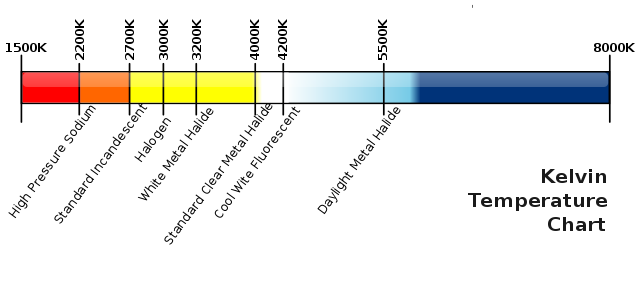
Light up to 5000 K is usually called warm, and above cold.
Among friends there are quite a few who prefer warm lighting. It seems to me because of the habit of incandescent lamps (2,200–3,000 K) and the low color rendition of most fluorescent lamps. Natural daylight, on average, has a color temperature of 6500 K.
There is still such a moment: the color perception of a person varies greatly depending on the light. With low light, we see better blue and worse red. Therefore, for each level of illumination there is the most appropriate range of color temperature of light sources.
The curve representing this relationship is named after the Dutch physicist Arie Andries Kruithof . Here she is:

Simply put, this means that dimmed light(20-50 lux) is best done warm (2000-3000K), and bright light (300-600 lux) - colder (4000-6000 K) .
The topic is extensive, worthy of a separate article.
The results of some studies indicate that cold light improves concentration, decreases drowsiness, etc. Apparently the fact is that short waves (blue, ultra-violet light) cause suppression of melatonin , a hormone that regulates daily rhythms and thus activates the body. In addition, there is evidence that bright cold light helps to cope with the winter depression Seasonal affective disorder (SAD) . But at the same time, a lack of melatonin can lead to sleep disturbance and other problems, so bright cold lighting at night will be more harmful.
Summarizing, we can say that moderate exposure to cold bright light during the daytime can reduce drowsiness and improve attention.
During the day, the color temperature of sunlight changes:
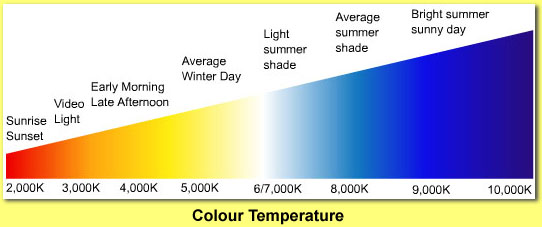
Also changes the light and direction of light. That is why it seems logical to do intense overhead lighting during the day and muffled warm for the evening.
In the end, I decided to make 2 lighting modes : daytime overhead light, with a color temperature of 4000K and an illumination of ~ 300 lux and an evening light of 2700K ~ 50 lux.
Since LED lamps are still too expensive, I stopped at fluorescent lamps. They are compact or in tubes. For me, the tubes have several advantages:
I chose the T8 Osram L 58W / 940 lamps (cost 240 rubles ), they have a good color rendering (Ra = 90) and a color temperature of 4000K.
Find for them inexpensive fixtures with good electronic ballasts failed. Therefore, I bought G13 cartridges (cost 9 p. ) And switched the lamps myself. The first version of the installation is presented in the title picture of the post, but it was unsuccessful. Later, I fixed the lamp with special plastic clips (cost 6 p. ).
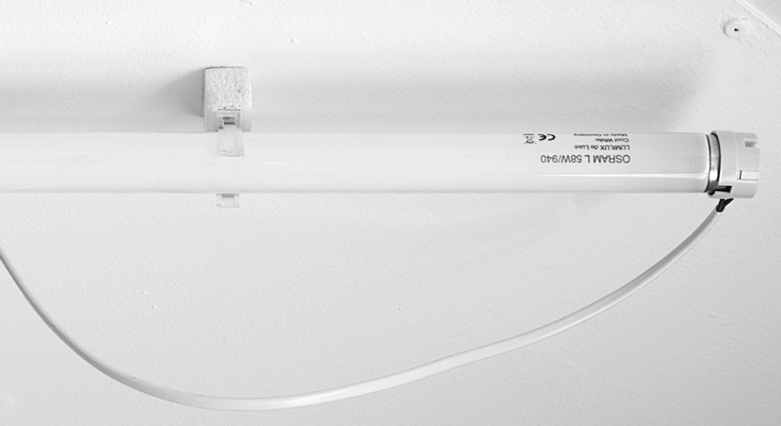
Osram QT-FIT8 2 × 58-70 Quicktronic (cost ~ 600 r. ) Are used as ECG for powering two lamps. The manufacturer recommends making the cables going from the electronic ballast to the lamp as short as possible, namely:
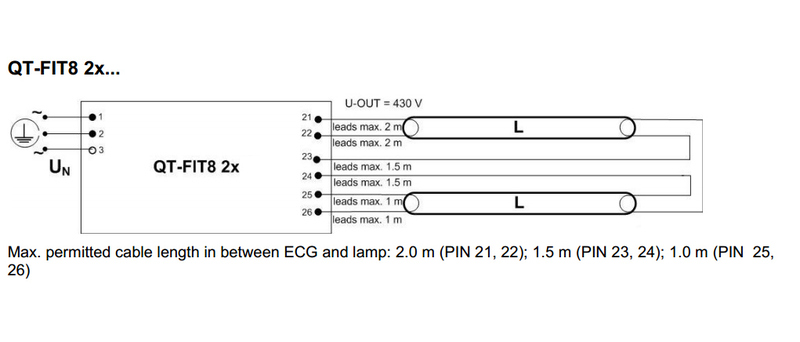
With a lamp length of 1.5 m, it was not easy to follow all the recommendations. The final connection option:
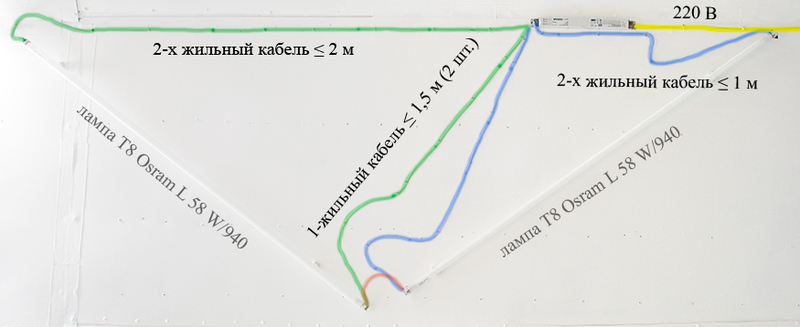
General form:

Total Illumination Measurement: 6.8 EV, i.e. approximately 300 lux.
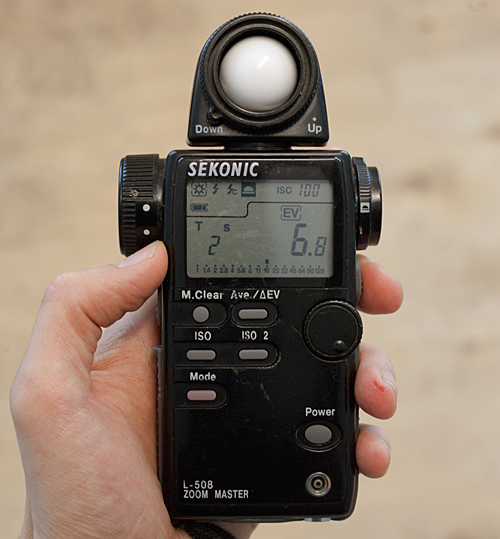
For the evening lower lighting a spherical lamp is used, which has become unnecessary after repairs in the apartment.
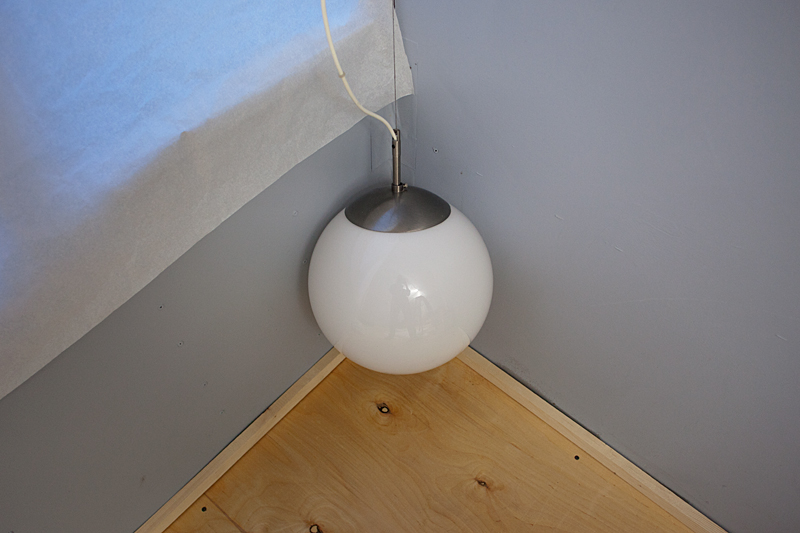
This note describes the general principles for creating comfortable lighting and the actual implementation of budget lighting for a residential workshop.

')
It began with the fact that I decided to turn the littered attic over the garage in Malakhovka near Moscow into a residential workshop to solder, drill and create there.
To implement the lighting it took to learn some of the fundamental characteristics:
Illumination
Illumination, roughly speaking, the amount of light falling per unit area is measured in Luxes (lux). In the afternoon, daylight illumination is usually between 2000 and 100,000 lux. The European standard for office lighting recommends the following illumination values:
| Illumination | Purpose |
|---|---|
| 300 lux | daily office work that does not require scrutiny of small details |
| 500 lux | reading, writing and working at the computer |
| 500 lux | meeting room lighting |
| 750 lux | technical drawing |
According to my observations, very many rooms in Russia suffer from an insufficient level of illumination, but in certain places there is also over-illumination . There is evidence that the wrong level of illumination can cause headaches, fatigue, visual disturbances and other troubles . (More details on Wikipedia: Light ergonomics , Light effects on circadian rhythm )
To understand how many lamps you need to create a certain level of illumination, you can use various methods of approximate calculation .
How to measure the light in your room?
Illumination is usually measured at the level of the working surface, such as a table. For simplicity, I measured at 1 m above the floor.
To measure the light, I used an exposure meter, instead I could measure the illumination approximately with a camera with an exposure meter. When measuring with an exposure meter, we get EV and then convert to lux using a table .
To measure the light, I used an exposure meter, instead I could measure the illumination approximately with a camera with an exposure meter. When measuring with an exposure meter, we get EV and then convert to lux using a table .
Color Rendering Index (CRI)
Light sources have such an important characteristic as the Color Rendering Index (CRI), the higher its value the better the color rendition, the maximum value Ra = 100.
This picture shows how the color rendition of red and blue hues in fluorescent lamps with low CRI suffers:

The name of fluorescent lamps usually contains 3 digits, the first digit characterizes the color rendition index 1 × 10 Ra.
The second and third indicate the color temperature of the lamp. For example, the most common 640 lamps are lamps with poor color reproduction 6 * 10 = 60 Ra and color temperature 40 * 100 = 4000K. Lamps with a low Ra are not suitable for residential premises , although they have a higher light output.
Colour temperature
Color temperature is, roughly speaking, the ratio of red and blue waves in the emission spectrum.

Light up to 5000 K is usually called warm, and above cold.
Among friends there are quite a few who prefer warm lighting. It seems to me because of the habit of incandescent lamps (2,200–3,000 K) and the low color rendition of most fluorescent lamps. Natural daylight, on average, has a color temperature of 6500 K.
There is still such a moment: the color perception of a person varies greatly depending on the light. With low light, we see better blue and worse red. Therefore, for each level of illumination there is the most appropriate range of color temperature of light sources.
The curve representing this relationship is named after the Dutch physicist Arie Andries Kruithof . Here she is:

Simply put, this means that dimmed light
What light is needed for productive work?
The topic is extensive, worthy of a separate article.
The results of some studies indicate that cold light improves concentration, decreases drowsiness, etc. Apparently the fact is that short waves (blue, ultra-violet light) cause suppression of melatonin , a hormone that regulates daily rhythms and thus activates the body. In addition, there is evidence that bright cold light helps to cope with the winter depression Seasonal affective disorder (SAD) . But at the same time, a lack of melatonin can lead to sleep disturbance and other problems, so bright cold lighting at night will be more harmful.
Summarizing, we can say that moderate exposure to cold bright light during the daytime can reduce drowsiness and improve attention.
Links to scientific articles
Subjective considerations
During the day, the color temperature of sunlight changes:

Also changes the light and direction of light. That is why it seems logical to do intense overhead lighting during the day and muffled warm for the evening.
In the end, I decided to make 2 lighting modes : daytime overhead light, with a color temperature of 4000K and an illumination of ~ 300 lux and an evening light of 2700K ~ 50 lux.
Lamp selection and installation
Since LED lamps are still too expensive, I stopped at fluorescent lamps. They are compact or in tubes. For me, the tubes have several advantages:
- ECG is separated from the lamp
- the tube has a much larger glass area with a luminous flux comparable to a compact lamp, thanks to which the light from it is softer and gives less glare
I chose the T8 Osram L 58W / 940 lamps (cost 240 rubles ), they have a good color rendering (Ra = 90) and a color temperature of 4000K.
Find for them inexpensive fixtures with good electronic ballasts failed. Therefore, I bought G13 cartridges (cost 9 p. ) And switched the lamps myself. The first version of the installation is presented in the title picture of the post, but it was unsuccessful. Later, I fixed the lamp with special plastic clips (cost 6 p. ).

Osram QT-FIT8 2 × 58-70 Quicktronic (cost ~ 600 r. ) Are used as ECG for powering two lamps. The manufacturer recommends making the cables going from the electronic ballast to the lamp as short as possible, namely:

With a lamp length of 1.5 m, it was not easy to follow all the recommendations. The final connection option:

General form:

Total Illumination Measurement: 6.8 EV, i.e. approximately 300 lux.

For the evening lower lighting a spherical lamp is used, which has become unnecessary after repairs in the apartment.

Related links
| Excellent article about the types of lamps and their spectrum | habrahabr.ru/post/116861 |
| An inside look: LED bulbs | habrahabr.ru/post/131216 |
| Health effects of fluorescent lamps | en.wikipedia.org/wiki/Fluorescent_lamps_and_health |
| Daylight source D 65 | en.wikipedia.org/wiki/Illuminant_D65 |
| Standard fluorescent lamps | en.wikipedia.org/wiki/Fluorescent-lamp_formats |
Source: https://habr.com/ru/post/161997/
All Articles